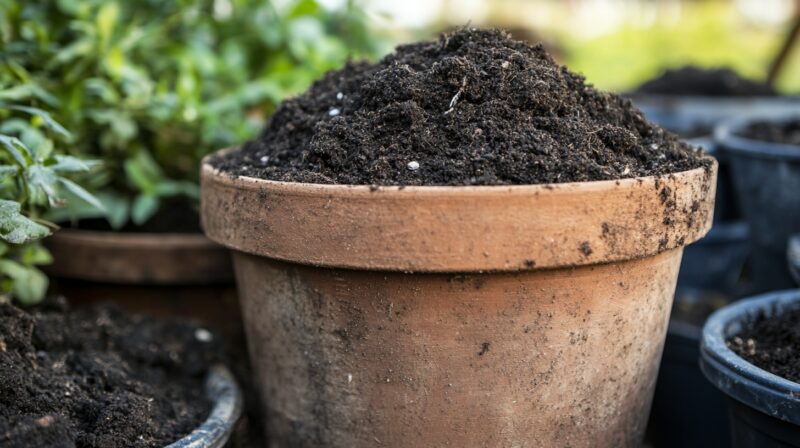The string of bananas (Senecio radicans) is a unique and eye-catching succulent known for its trailing growth and banana-shaped leaves.
Its cascading appearance makes it ideal for hanging baskets or as a ground cover in outdoor spaces.
Originating from South Africa, this plant thrives in warm, dry climates, making it a perfect low-maintenance option for gardeners seeking a visually appealing addition to their outdoor collections.
Choosing the Right Location
First, we want to touch upon the factors you need to check before you find the right location to plant a banana tree.

Light Requirements
Selecting the right location is crucial for the healthy growth of a string of banana plants.
This succulent prefers bright, indirect light, making it well-suited for partially shaded areas outdoors. Direct sunlight, especially during the hottest part of the day, can cause the leaves to burn, leading to unsightly damage.
In milder climates, such as coastal regions like Santa Barbara, the plant can handle more sunlight due to the less intense sun, but it’s still important to avoid prolonged direct exposure.
Temperature Needs
This plant thrives in warm temperatures, ideally between 70°F to 80°F. It can tolerate brief dips in temperature down to 30°F, but extended exposure to cold, particularly below freezing, can be harmful.
If temperatures are expected to drop, covering or bringing it indoors is essential to prevent frost damage.
String of bananas is not frost-tolerant and prefers a warm, dry environment, so it is particularly suited for climates with minimal cold weather.
Soil and Potting

Proper soil selection is critical for the string of banana plants, as it is prone to root rot if the soil retains too much moisture. It thrives in well-draining soil, such as a cactus or succulent mix, with added perlite or pumice to improve drainage.
These soil amendments help prevent water from pooling around the roots, which can lead to rot. Ensuring that the soil dries out between waterings is a key part of keeping it healthy.
Repotting is recommended every 2-3 years, typically during the active growing season in spring or summer. When repotting, it’s important to position the crown above the soil line to prevent water accumulation and potential rot.
Choosing a slightly larger pot with good drainage can give the plant more space to grow while avoiding waterlogged conditions.
Regular repotting also refreshes the soil, helping the plant access nutrients and preventing compaction.
Watering Guidelines

Watering is an essential factor that requires your attention. However, it is an absolute must to be careful about how frequently this should be done.
Frequency
The watering needs of the string of bananas vary based on the season and climate.
During the warm summer months, watering once a week is typically sufficient, although this may need to be adjusted depending on the local heat conditions.
As the weather cools, particularly in fall and winter, the plant’s water requirements decrease.
Watering every 2-3 weeks is generally recommended during these cooler months. It’s important to let the soil dry out between waterings to prevent root rot.
Signs of Over/Under Watering
Recognizing signs of overwatering and underwatering can help maintain its health.
Overwatering usually manifests as yellowing leaves and mushy stems, indicating the roots are waterlogged.
On the other hand, underwatering leads to wrinkled leaves and brown tips, signaling that the plant needs more moisture.
Keeping an eye on these signs and adjusting the watering schedule accordingly can prevent damage and promote strong growth.
Fertilization

Although the string of bananas does not require heavy fertilization, providing some nutrients during the growing season can enhance its growth.
Organic fertilizers like worm compost, fish emulsion, or liquid kelp are excellent options for enriching the soil without overwhelming the plant.
Light fertilization every 4-6 weeks during the spring and summer months can give it a much-needed boost. However, it’s important not to over-fertilize, as this can cause salt buildup in the soil, which may harm the plant’s delicate roots.
Pests and Diseases
While generally resilient, the String of Bananas plant is occasionally susceptible to common pests such as aphids, mealybugs, and spider mites.
These pests can damage the plant by sucking the sap from the leaves, leading to weakened growth and a poor appearance.
Regular inspection of the plant, particularly the underside of leaves, can help identify pest infestations early. Using pesticides, neem oil or insecticidal soap is an effective way to control these pests without harming the plant or the environment.
One of the biggest threats is root rot, which occurs when the soil remains waterlogged for extended periods.
Watering the plant correctly—allowing the soil to dry out between waterings—is also critical in avoiding root rot.

Propagation
Propagating the string of banana plants is simple and highly rewarding. This succulent is easily propagated through stem cuttings, making it a great plant to share with friends or expand your garden.
To propagate, cut 2-3 inches of stem, and allow the cutting to dry and form a callus for a few days.
Once the cutting has dried, plant it in well-draining soil, and water it sparingly until roots begin to establish. Within a few weeks, the new plant should start growing, making propagation an effortless way to multiply your collection.
Seasonal Care
Different seasons will come with a different set of requirements when it comes of taking care of your banana plant.
Summer
During the summer, the string of bananas thrives outdoors, but it’s important to protect it from strong summer rains that could cause the soil to become waterlogged.
If heavy rain is expected, consider moving the plant to a covered area to avoid excessive moisture. In regions with extremely hot summers, providing some shade during the hottest part of the day can help prevent leaf burn.
Winter
In colder months, especially when temperatures drop below 30°F, the plant should be brought indoors or protected with coverings.
Moving the plant indoors should be done gradually to avoid stress caused by sudden temperature changes. Ensuring the plant gets enough light indoors, such as placing it near a bright window, will help it thrive during the winter.
Pruning and Maintenance
Regular pruning helps to control the size of the string of banana plants, promoting fuller growth and removing any dead or unhealthy stems. Pruning encourages the plant to focus its energy on producing new, healthy growth, keeping it looking lush and tidy.
Trimming back long, leggy stems will result in a denser and more compact plant. Pruning can also help keep the plant manageable, especially if it’s growing in a small space or container.
The Bottom Line
The string of bananas is a perfect outdoor plant for warm climates, offering a low-maintenance yet stunning addition to gardens.
With proper care, it will thrive, creating lush hanging baskets or ground cover that is both hardy and beautiful.







